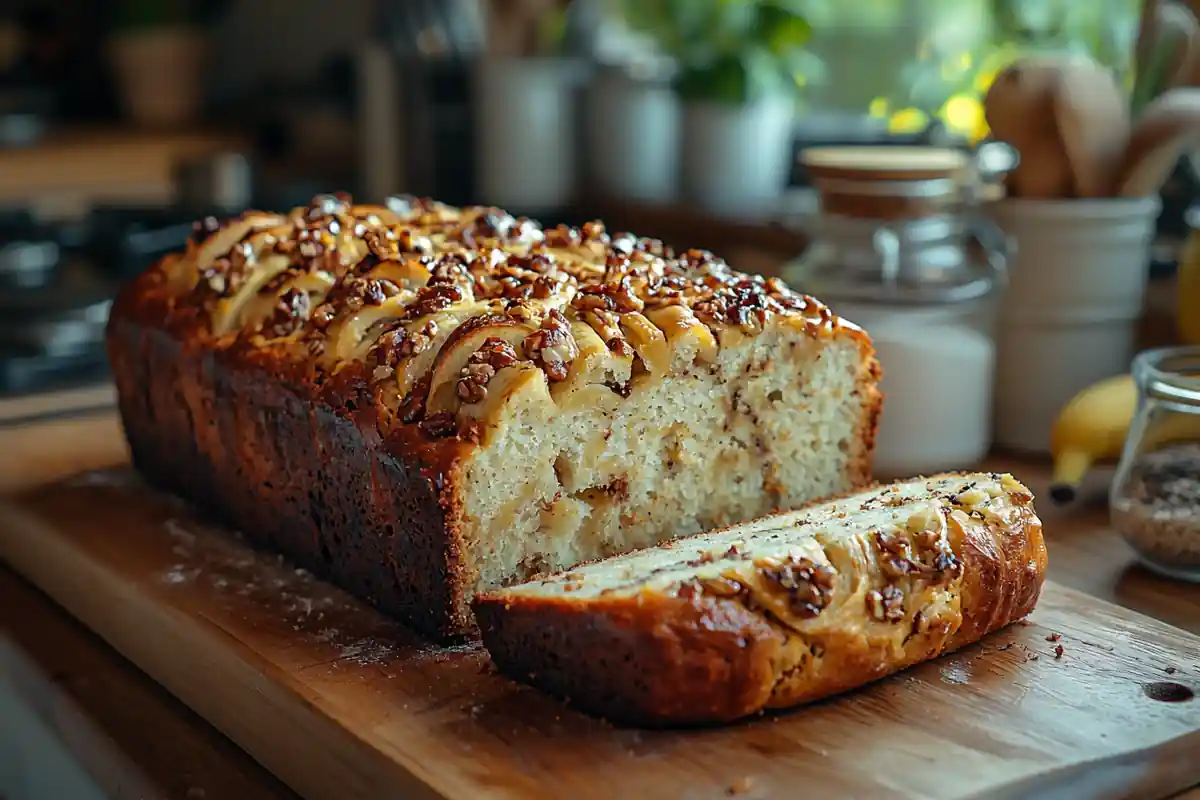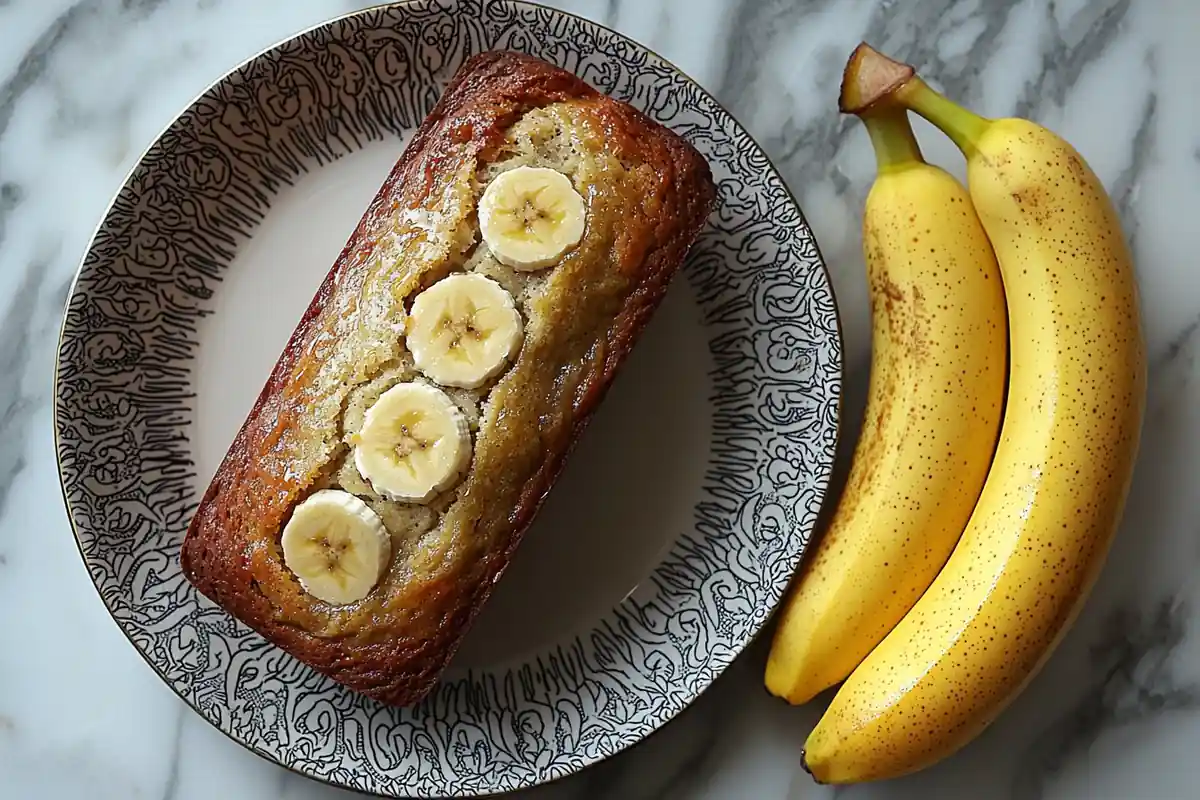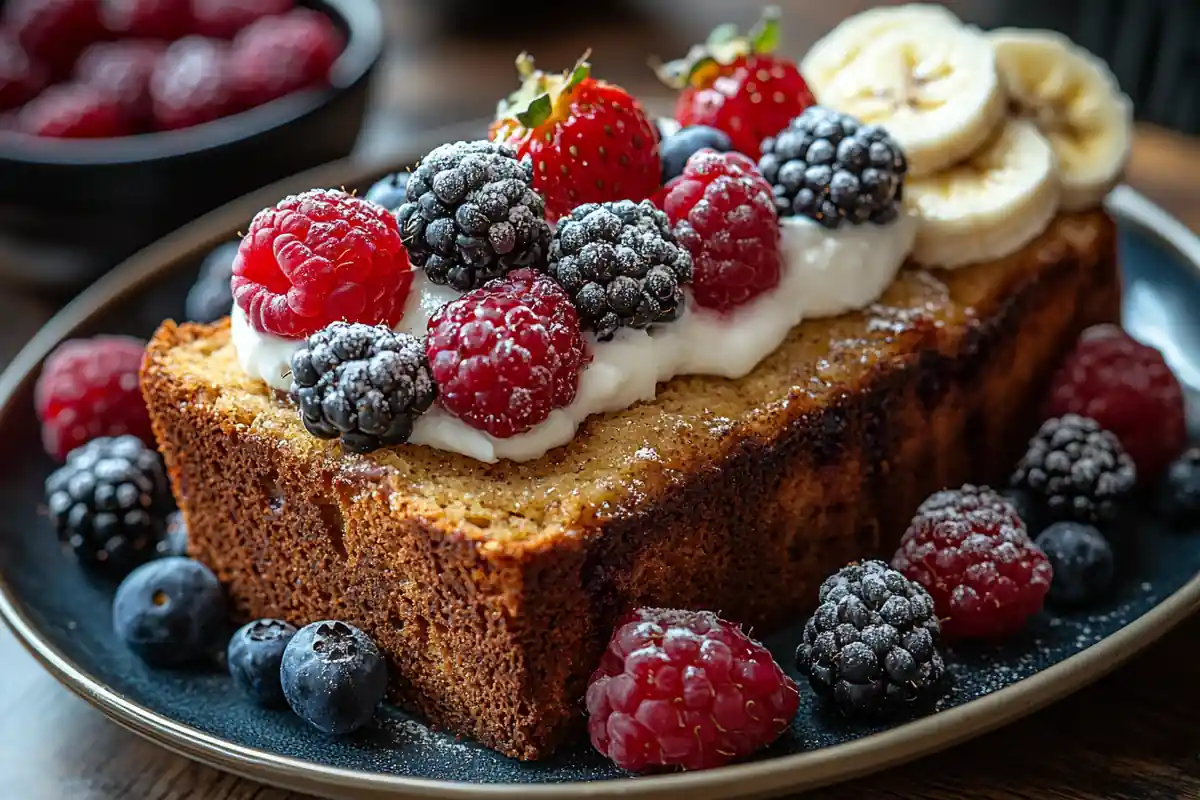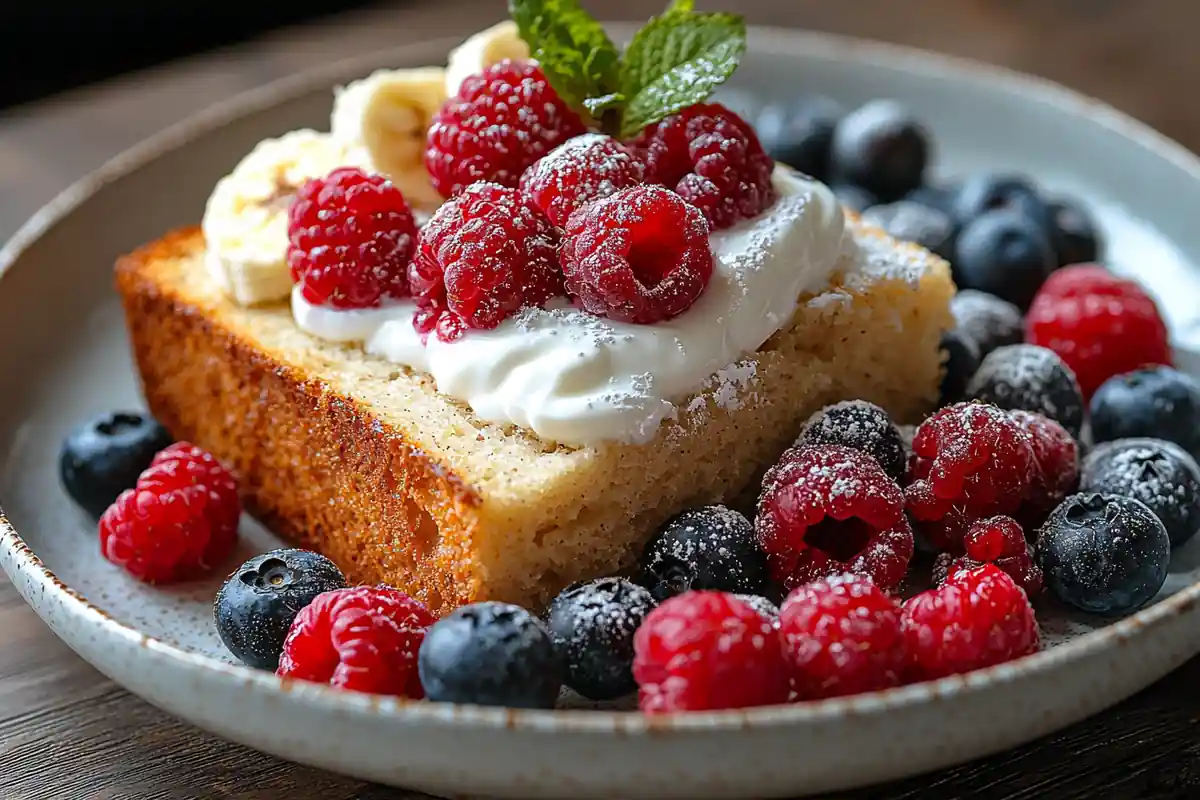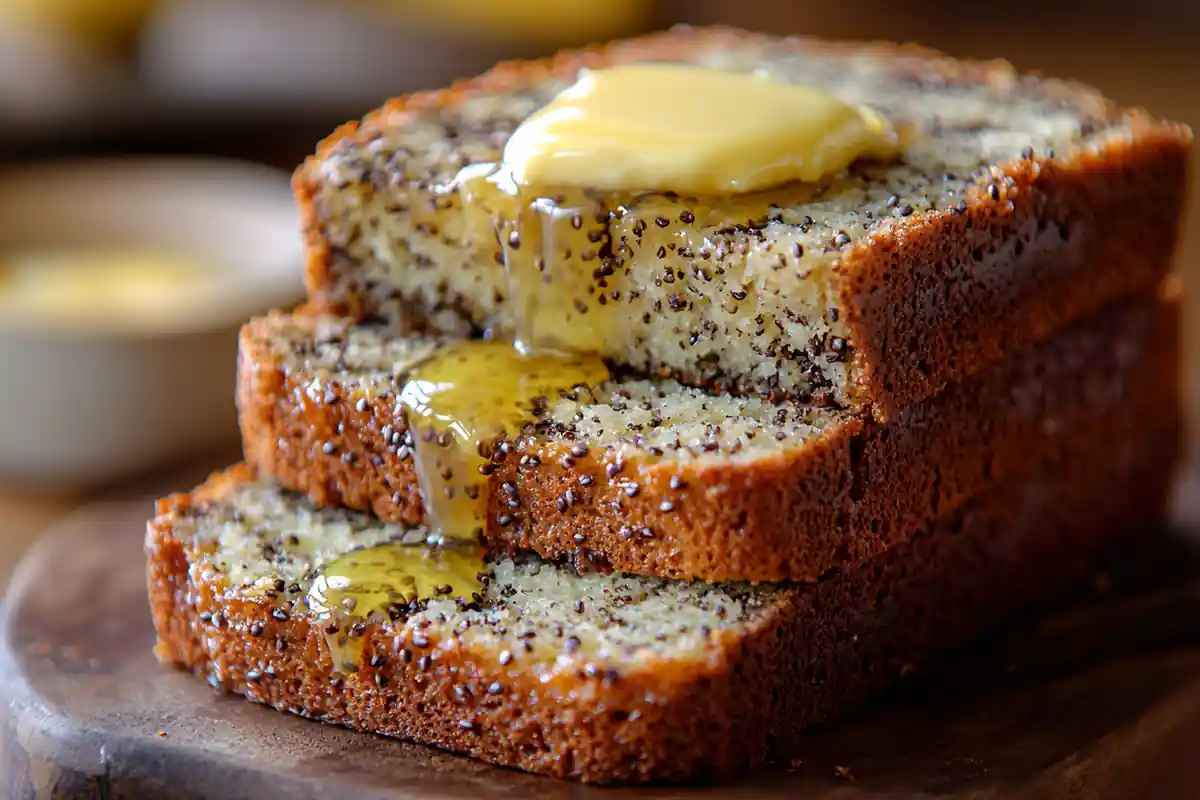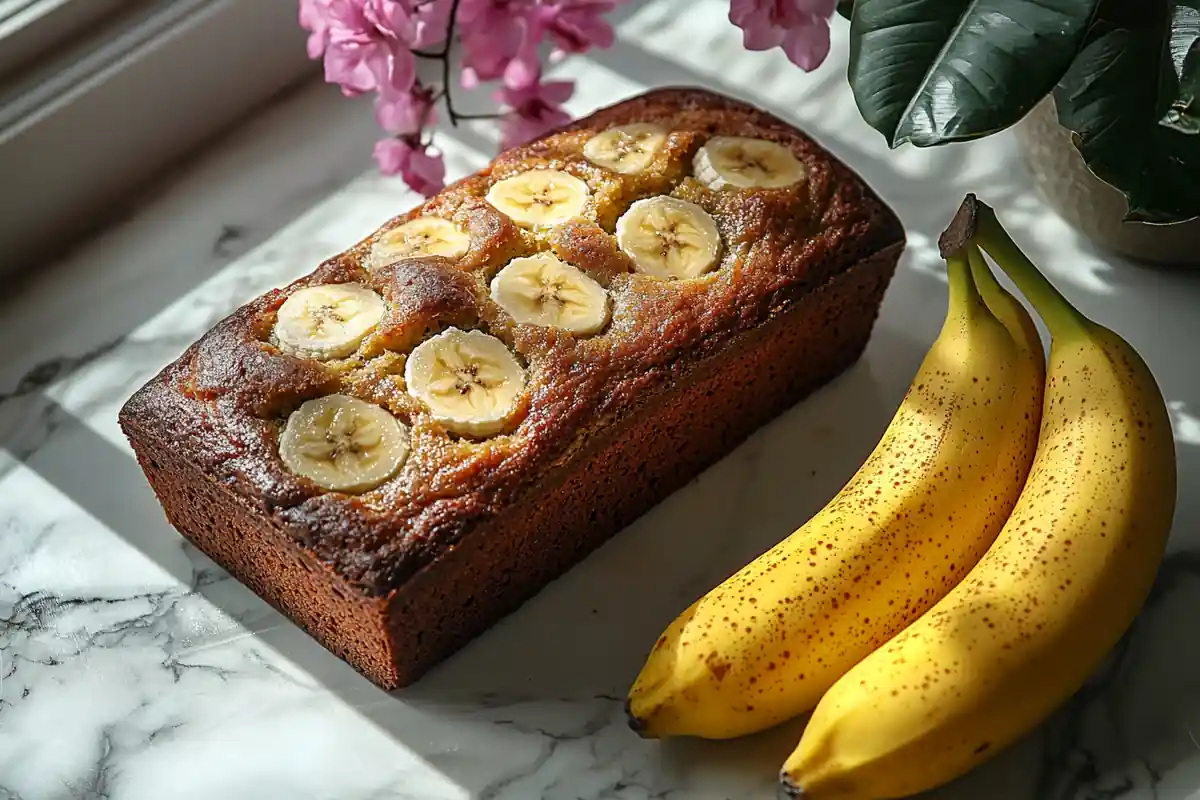Table of Contents
ToggleIntroduction
Let’s be real—everyone has a couple of overripe bananas sitting on their counter now and then. And while you could toss them into the compost, wouldn’t it be so much better to turn them into something cozy, delicious, and effortlessly satisfying? That’s where this banana bread recipe with 2 bananas swoops in like your kitchen’s unsung hero.
Whether you’re short on bananas or just craving a small-batch, one-bowl miracle, this guide walks you through the perfect way to bake a moist and rich loaf of banana bread using just two bananas. From pantry-friendly ingredients and baking hacks to nutrition facts and pro tips, we’ve packed this article with everything you need. Oh—and we didn’t forget the most Googled questions, either. Stick around, and you’ll learn it all.
Banana Bread Recipe with 2 Bananas
Why 2 Bananas Is the Sweet Spot
Here’s the thing—2 bananas strike the ideal balance. Not too much moisture. Not too dense. Just enough fruit to deliver that iconic flavor and rich texture you expect in a classic banana bread.
Additionally, using two overripe bananas gives you just the right amount of sweetness without needing loads of sugar. And guess what? It means less waste, more taste.
But what really seals the deal? You can make it with pantry basics you likely already have. No fuss. No drama. Just the good stuff.
Let’s dive right into the nitty-gritty.
Perfect Ingredients for Banana Bread with 2 Bananas
The following ingredients yield one standard 8.5 x 4.5 loaf pan.
Ingredients
-
2 ripe bananas, mashed well
-
1 ½ cups all-purpose flour
-
½ cup granulated sugar (or brown sugar for a richer flavor)
-
1 large egg
-
⅓ cup unsalted butter, melted
-
1 teaspoon vanilla extract
-
1 teaspoon baking soda
-
½ teaspoon salt
-
Optional: ½ teaspoon cinnamon, ½ cup chopped walnuts or chocolate chips
Looking for healthier swaps? You can replace butter with coconut oil or use Greek yogurt for a protein boost. For a deeper dive into ingredient science, check out this beginner’s guide to baking to understand the role of each component.
How to Make Banana Bread with 2 Bananas
Follow this step-by-step method for perfect results every time.
-
Preheat the oven to 350°F (175°C). Grease or line your loaf pan with parchment paper.
-
In a large bowl, mash the bananas with a fork until creamy.
-
Add the melted butter to the mashed bananas and stir well.
-
Crack in the egg, pour the vanilla extract, and mix until fully combined.
-
In a separate bowl, whisk together the flour, sugar, baking soda, salt, and cinnamon.
-
Fold the dry mixture gently into the wet ingredients using a spatula. Don’t overmix—it should be lumpy.
-
If you’re using nuts or chocolate chips, stir them in now.
-
Pour the batter into the prepared loaf pan and level the top with a spatula.
-
Bake for 50–60 minutes or until a toothpick inserted in the center comes out clean.
-
Let the bread cool in the pan for 10 minutes before transferring it to a wire rack.
And that’s it! Easy peasy. No mixer, no stress.
Nutritional Content (Per 100g)
Here’s what you’re biting into—more than just flavor!
| Nutrient | Amount |
|---|---|
| Calories | 275 kcal |
| Carbohydrates | 42 g |
| Sugars | 18 g |
| Protein | 4.2 g |
| Fat | 10.5 g |
| Saturated Fat | 5.8 g |
| Fiber | 1.9 g |
| Sodium | 220 mg |
Pro Tip: Measuring Flour Matters
Want to avoid dry, crumbly banana bread? Measure your flour the right way—spoon it into the cup and level it off. Scooping directly from the bag can compact the flour, making your batter too thick. Learn more at The Kitchn’s flour measuring guide.
Perfect Ingredients for Banana Bread with 2 Bananas
What Makes It Moist and Rich?
It all begins with overripe bananas. Those speckled, squishy ones that look like they’ve seen better days? Yeah—those are gold. Why? Because they bring a deeper banana flavor and more natural sweetness to the batter. Plus, they add a luxurious moistness that oil or butter alone can’t replicate.
And speaking of fats—melted butter is your next best friend. It adds richness, helps the bread brown beautifully, and brings that nostalgic homemade taste. Some folks opt for oil, and while it keeps the bread soft, it lacks that toasty depth. If you’re after the best of both worlds, try using half butter and half oil.
Meanwhile, eggs act as binders, giving structure to your loaf. Want a plant-based version? You can swap the egg with a flaxseed egg or ¼ cup of applesauce without sacrificing too much texture.
To ensure it rises perfectly and avoids becoming dense, you’ll want to use fresh baking soda. Don’t skip it—it reacts with the acid in bananas to lift your bread like a champ.
Substitutes for Common Ingredients
What if your pantry is looking a little bare? Don’t sweat it. Here are quick swaps that’ll still keep things delicious:
-
No eggs? → Use ¼ cup unsweetened applesauce or a chia/flaxseed egg.
-
No butter? → Try melted coconut oil or olive oil for a lighter flavor.
-
Out of sugar? → Use maple syrup or honey, but reduce the liquid slightly.
-
No vanilla? → A splash of almond extract or a pinch of cinnamon will elevate the taste.
These substitutions not only come in handy when you’re in a pinch, but they also help customize your banana bread for special diets or personal preferences.
Pantry Staples You’ll Need
Let’s keep it simple. No fancy ingredients. Here’s a quick checklist you can run through:
-
All-purpose flour – the backbone of the loaf
-
Baking soda – makes it rise
-
Salt – enhances the overall flavor
-
Granulated or brown sugar – sweetness and caramel tones
-
Vanilla extract – adds warmth
-
Melted butter or oil – for that rich, tender crumb
-
Egg – adds structure and binds everything
-
2 ripe bananas – the star of the show
To get the most out of your baking, don’t forget to scan through this Nutritional Guide to Bananas if you’re curious about what you’re really putting into your body.
Quick Storage Note
When buying bananas just for baking, try this trick: let them ripen fully on the counter. If they ripen too fast, pop them in the fridge—the skins might darken, but the fruit inside stays perfect. For long-term plans, peel and freeze them. Defrost and mash when you’re ready to bake. No waste, no rush.
Essential Kitchen Tools for Banana Bread
Must-Have Baking Tools
You don’t need a Michelin-starred kitchen setup to bake this beauty. In fact, the simpler your tools, the smoother your bake. Still, there are a few essentials you absolutely don’t want to skip—trust me.
Here’s your go-to gear list for this recipe:
-
Mixing bowls: One large for the wet ingredients, and one smaller for dry—helps avoid overmixing.
-
Fork or potato masher: To mash those bananas to soft, dreamy perfection.
-
Rubber spatula: Ideal for folding the batter gently without deflating it.
-
Measuring cups and spoons: Precision is key when it comes to flour and baking soda.
-
Loaf pan (8.5 x 4.5 or 9 x 5 inch): This size gives you a perfectly shaped loaf with a tender crumb and domed top.
-
Toothpick or cake tester: For the ultimate “done check” in the center.
-
Wire cooling rack: It’s not just for pros—cooling the bread evenly prevents sogginess.
Now, if you’re just starting out or wondering about quality tools, the Beginner’s Guide to Baking offers a deeper dive into why these tools matter.
Can You Use a Toaster Oven?
Absolutely, and surprisingly, it’s one of the best-kept secrets for small-batch baking. A toaster oven works wonders if you’re in a tiny kitchen, don’t want to heat up the house, or just crave banana bread on the fly.
Here’s how to do it right:
-
Use a mini loaf pan (or split the batter into two mini pans)
-
Lower the temperature slightly (325°F instead of 350°F) to avoid overbrowning
-
Check doneness early – around the 30-minute mark
A toaster oven traps heat closer to the batter, so it can bake quicker. But beware—it can also overbake if left unattended. Keep an eye on your loaf, and you’ll be golden (literally).
Plus, it’s perfect for those who only want a small-batch banana bread fix. You get the same cozy aroma, same comforting taste—but with a shorter wait and less cleanup.
How to Make Banana Bread with 2 Bananas
Step-by-Step Baking Guide
Ready to turn your kitchen into a cozy banana-scented haven? Here’s the detailed breakdown of how to nail this banana bread recipe with 2 bananas—no stress, no mess.
Step 1: Prep the Oven and Pan
Preheat your oven to 350°F (175°C). While it’s warming up, grease your loaf pan with butter or line it with parchment paper. A little prep goes a long way—nothing’s worse than a perfect loaf that sticks to the pan!
Step 2: Mash the Bananas
In a large mixing bowl, mash the bananas with a fork or potato masher until they’re smooth with small lumps. Ripe bananas break down easily—if yours are firm, let them sit for a day or microwave them for 15 seconds.
Step 3: Add the Wet Ingredients
Pour melted butter over the bananas and stir until combined. Crack in the egg, then add the vanilla extract. Mix it all up until smooth.
Pro tip: Let the melted butter cool slightly before mixing to avoid scrambling the egg.
Step 4: Combine Dry Ingredients
In a separate bowl, whisk together:
-
1½ cups flour
-
½ cup sugar
-
1 tsp baking soda
-
½ tsp salt
-
½ tsp cinnamon (optional)
This step keeps things even and prevents clumps.
Step 5: Fold Together
Add the dry mix to the wet ingredients. Use a spatula and gently fold the batter together—no vigorous stirring! Overmixing can create a tough, chewy loaf. The batter should look thick and slightly lumpy.
At this stage, fold in any extras—chocolate chips, walnuts, or even blueberries. Totally up to you!
Step 6: Bake
Pour the batter into your prepared loaf pan and spread it out evenly.
Place it in the center of the oven and bake for 50–60 minutes. At the 50-minute mark, insert a toothpick into the center. If it comes out clean (a few moist crumbs are fine), you’re good to go.
Step 7: Cool and Slice
Let the banana bread cool in the pan for 10–15 minutes, then transfer it to a wire rack. Waiting helps it firm up and slice better. Trust us—it’s worth the wait.
Now slice it up, smear it with butter (or not), and savor every bite of that tender, golden crumb.
Baking Times and Temperatures
Depending on your oven and pan, times may vary slightly. Here’s a quick cheat sheet:
| Oven Type | Temp | Bake Time |
|---|---|---|
| Conventional Oven | 350°F / 175°C | 50–60 mins |
| Toaster Oven | 325°F / 160°C | 35–45 mins |
| Mini Loaf Pans | 350°F / 175°C | 25–30 mins |
Always test with a toothpick before pulling it out!
Tips for Even Baking
-
Rotate the pan halfway through baking if your oven has hot spots.
-
Use the middle rack to avoid over-browning the bottom or top.
-
Let ingredients come to room temperature before mixing—it makes a big difference.
And remember: banana bread continues to firm up as it cools, so if it feels too soft straight out of the oven, give it a few minutes.
Serving Suggestions for Banana Bread
Warm or Cold? Butter or Not?
Banana bread is one of those rare treats that tastes amazing at any temperature. But let’s be real—a warm slice slathered with a bit of butter is basically heaven in edible form.
If you’re in the mood for something cozy, warm your slice for 10–15 seconds in the microwave. That revives the crumb and melts the butter just right. Want a little crunch? Pop it into the toaster for that lightly crisped edge with a soft center.
Looking for a fun twist? Here’s how people are serving it up:
-
With a dollop of Greek yogurt and honey
-
Toasted and topped with almond butter and sliced strawberries
-
As a base for French toast (yup, it’s wild but amazing!)
This humble loaf is way more versatile than people give it credit for. And guess what? It’s even better the next day. The flavors deepen, the crumb tightens slightly, and the texture becomes extra dreamy.
How to Store for Freshness
Keeping your banana bread fresh is easy—as long as you avoid a few common pitfalls.
Short-Term (Up to 3 Days)
-
Store it at room temperature, tightly wrapped in foil or plastic wrap.
-
You can also use an airtight container lined with a paper towel to absorb moisture.
Mid-Term (Up to 1 Week)
-
Pop the loaf in the fridge (still tightly wrapped).
-
It may firm up a bit, so reheat slices in the microwave to bring them back to life.
Long-Term (Up to 3 Months)
-
Wrap slices or the whole loaf in plastic wrap, then foil.
-
Freeze them in a zip-lock freezer bag.
-
Defrost at room temp or microwave for 20–30 seconds per slice.
Don’t forget to label the bag with the date, so you know when it’s best to eat!
Can You Freeze Banana Bread?
Absolutely—and it freezes like a dream! In fact, frozen banana bread retains its moisture better than many other baked goods. This makes it perfect for meal prepping or keeping on hand for surprise guests or future cravings.
To freeze:
-
Slice the loaf completely (or not, your call)
-
Wrap each slice individually or the whole loaf in plastic wrap
-
Place in a freezer-safe container or bag
To thaw:
-
Leave on the counter for 1–2 hours
-
Or microwave slices for a quick warm-up
Freezing banana bread actually enhances the flavor. Wild, right? But true.
Delicious Variations of Banana Bread with 2 Bananas
Add-ins: Chocolate, Nuts, and More
One of the absolute best things about banana bread is how versatile it is. Once you’ve got the basic recipe down, you can riff on it a hundred different ways—and every version feels like a whole new treat.
Here are some tasty variations to give your banana bread a personal spin:
-
Chocolate Chip Banana Bread – Toss in ½ to ¾ cup of semi-sweet or dark chocolate chips for melty bursts of goodness in every bite.
-
Walnut Banana Bread – Add ½ cup chopped walnuts for a toasty crunch and nutty depth. Pecans work beautifully too.
-
Coconut Banana Bread – Fold in ¼ cup shredded coconut for an unexpected tropical vibe.
-
Banana Bread with Berries – Blueberries or raspberries add a pop of freshness. Just make sure to gently fold them in to avoid bleeding.
Pro tip: Lightly dust your add-ins with flour before mixing them into the batter. It helps prevent them from sinking to the bottom of your loaf.
Whether you’re baking for guests or just want to level up your loaf, these simple tweaks can turn ordinary banana bread into something extraordinary.
Make It Vegan or Gluten-Free
Got dietary restrictions? No worries—you can still enjoy this cozy classic with just a few thoughtful swaps.
Vegan Version
-
Replace the egg with a flaxseed egg (1 tbsp ground flax + 3 tbsp water, let sit 5 mins).
-
Use melted coconut oil or plant-based butter instead of dairy butter.
-
Choose a non-dairy milk splash (if adding extra moisture or adjusting texture).
The result? Still super moist, flavorful, and 100% egg-free delicious.
Gluten-Free Option
-
Use a 1:1 gluten-free baking flour blend.
-
Make sure your baking soda is certified gluten-free.
-
Don’t forget: gluten-free batters can be a little more delicate, so let your loaf cool fully before slicing.
You won’t even notice the difference—promise.
Banana Muffins Instead?
Short on time or want built-in portions? This exact banana bread batter also makes fantastic muffins. Perfect for lunchboxes, quick breakfasts, or easy snacking.
Here’s how:
-
Line a 12-cup muffin tin with paper liners.
-
Divide the batter evenly among cups (about ¾ full).
-
Bake at 350°F (175°C) for 20–25 minutes.
-
Toothpick test at 20 minutes to check doneness.
Same delicious flavor, faster bake time, and no slicing required. Handy, huh?
Common Mistakes to Avoid
Why Is My Banana Bread Dry?
Nothing’s more disappointing than slicing into your homemade loaf only to find it’s dry, dense, or crumbly. But don’t worry—you’re not alone. This is one of the most common issues home bakers face.
Here are some likely culprits and how to fix them:
-
Too much flour: This is the number one suspect. Measuring flour the wrong way (by scooping with the measuring cup) packs in more flour than needed. Instead, spoon it into the cup and level it off for accuracy.
-
Not enough banana: If your bananas were on the small side or under-ripe, they might not provide enough moisture. Next time, add a splash of milk or yogurt to balance it out.
-
Overbaking: Even 5 extra minutes in the oven can dry it out. Always start checking at the earliest suggested time.
-
Oven temperature off: An oven that runs too hot can burn the outside while leaving the inside underdone. Use an oven thermometer to double-check yours.
Want to avoid the flour trap? Learn the right technique with this guide on how to properly measure flour—a total game-changer.
My Banana Bread Didn’t Rise—Why?
That glorious domed top? It’s not magic—it’s chemistry.
If your banana bread turned out flat, here’s what may have gone wrong:
-
Expired baking soda: It loses potency over time. Always check the date and test it with vinegar if unsure.
-
Overmixed batter: Stirring too much knocks the air out and can result in a dense, sad loaf. Fold gently until just combined.
-
Too much banana or liquid: More isn’t always better. Excess moisture weighs the batter down, so stick to the ratio in the recipe.
-
Underbaking: If the center isn’t fully set, it’ll collapse as it cools. Use a toothpick test in the deepest part of the loaf.
Just a few tweaks and your next banana bread will rise to the occasion—literally.
Bonus Tip: Cool It Right
This one’s often overlooked: cooling.
Leaving your loaf in the hot pan for too long can steam the bottom crust and turn it soggy. Transfer it to a wire rack after 10–15 minutes to keep the texture spot on.
Let’s be honest—banana bread has a way of forgiving your kitchen sins. But with these fixes, you’re not just baking—you’re elevating your loaf game.
Is Banana Bread Healthy?
Calories in a Slice
Okay, let’s cut to the chase—banana bread isn’t exactly a salad. But it’s also not a guilty pleasure if you know what’s in it and how to tweak it smartly. A standard slice (about 100g) from this banana bread recipe with 2 bananas clocks in around 275 calories, depending on your ingredients.
Here’s a general idea of what’s packed into every 100 grams of this golden loaf:
| Nutrient | Amount (per 100g) |
|---|---|
| Calories | 275 kcal |
| Carbohydrates | 42 g |
| Sugars | 18 g |
| Protein | 4.2 g |
| Fat | 10.5 g |
| Saturated Fat | 5.8 g |
| Fiber | 1.9 g |
| Sodium | 220 mg |
Not too shabby, right? Especially when compared to store-bought loaves that come with additives, preservatives, and mystery ingredients you can’t pronounce.
Sugar, Fats, and Fiber Explained
Most of the sugar in banana bread comes from ripe bananas and added sweeteners like sugar or honey. You can cut back on added sugar if your bananas are extra ripe—nature’s candy, after all.
As for fats, butter or oil contributes to the moist texture. You can swap in Greek yogurt or applesauce to lighten things up without sacrificing flavor.
And fiber? Bananas + flour + optional add-ins like oats or nuts = a slice that does more than just taste good. Boost the fiber by subbing part of the all-purpose flour with whole wheat flour or tossing in a spoonful of chia seeds.
Healthy Substitutes to Try
Wanna make your loaf a little more wholesome? Here are some guilt-free tweaks:
-
Use whole wheat flour for added fiber and nutrition
-
Substitute sugar with maple syrup or mashed dates
-
Add flaxseeds or chia for omega-3s and a fiber boost
-
Swap butter for Greek yogurt to reduce saturated fat
-
Toss in blueberries or grated carrots for extra vitamins
With these swaps, banana bread transforms from indulgent snack to breakfast superstar.
Expert Tips for Banana Bread Perfection
Ripe Bananas: Too Much or Just Enough?
Here’s the golden rule: the riper the banana, the better the bread. You’re looking for bananas with lots of brown spots, even if the skin looks too far gone. Inside, they should be soft, sweet, and super aromatic.
That said—can bananas ever be too ripe? Technically yes. If they’re oozing liquid or smell fermented, you’re entering banana wine territory… and nope, we’re not going there. When in doubt, cut it open. If it’s black and mushy inside, toss it.
Banana hack: If your bananas aren’t ripe enough, throw them in the oven at 300°F (150°C) for 10–15 minutes until the skins blacken. Let them cool, then mash away.
The Secret Ingredient Pros Use
Want to know what takes banana bread from “pretty good” to absolutely next level?
Sour cream. Or Greek yogurt.
Just a spoonful or two added to your batter creates a softer crumb, tender texture, and rich flavor. The acidity helps activate baking soda and balances the sweetness of the bananas.
Other chef-worthy upgrades:
-
A dash of nutmeg or clove adds warmth.
-
Espresso powder (just a pinch) intensifies the banana flavor—seriously!
-
Swap vanilla for almond extract to shake things up.
Oh, and always use room temperature ingredients. Cold eggs or butter can seize up the batter and mess with the rise. Let them sit out for 15–20 minutes before mixing.
Let the Loaf Rest Before Slicing
Yes, I know it smells amazing. And yes, you want to cut into it right away. But hear me out—waiting just 30 minutes before slicing lets the structure settle. It avoids crumbling, locks in moisture, and gives you cleaner cuts.
If you’re feeling extra patient, let it sit overnight. Wrapped in foil and stored at room temp, banana bread gets even better the next day. The flavors meld, and the moisture redistributes evenly. It’s magic.
Want to see how others are putting their own spin on banana classics? Take a peek at Nory Recipes’ banana pancake twist—perfect if you’ve got just one ripe banana left after baking this loaf.
FAQs on Banana Bread Recipe with 2 Bananas
What if I don’t have enough bananas for banana bread?
No worries—you’re not out of options! If you’re short a banana, try one of these swaps:
-
Add ¼ cup unsweetened applesauce for each missing banana
-
Use ½ a mashed avocado for a creamy, healthy alternative
-
Mix in plain Greek yogurt or sour cream to boost moisture
Each of these maintains the softness and moisture banana bread is known for, even when you’re one fruit short.
Still curious about banana substitutions? Nory Recipes’ banana-free muffins might be worth bookmarking for next time.
How many cups is 2 bananas?
On average, 2 medium bananas (fully mashed) equals about 1 cup.
Of course, banana sizes vary. If you’re unsure, measure the mashed fruit in a standard cup. A little more or less won’t ruin the recipe—banana bread is pretty forgiving.
How many bananas do you need for banana bread?
Typically, banana bread recipes call for 2 to 4 ripe bananas. But this guide proves that 2 bananas are enough to make a flavorful, moist, and well-balanced loaf.
In fact, too many bananas can lead to a gummy, underbaked center. So if you’ve only got two? You’re actually in perfect shape.
What is the number one mistake made when making banana bread?
Hands down, the most common mistake is overmixing the batter.
Once you combine the wet and dry ingredients, stir gently until the flour disappears—then stop. Overworking the batter can make your bread dense and tough instead of soft and tender.
Other close contenders?
-
Using under-ripe bananas
-
Not measuring flour correctly
-
Overbaking or underbaking
-
Skipping the toothpick test
Stick to the tips in this article, and you’ll avoid these pitfalls like a pro.

